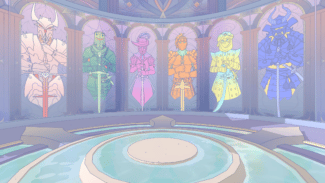By valuing strategic finesse over brute force, Broken Edge offers a refined take on VR fantasy sword fighting. Developed by Trebuchet, this multiplayer dueling game is available now on Steam and the Meta Quest platform. Read on for our full Broken Edge review for Quest 2 and SteamVR.
Broken Edge sees you take up arms against other players in sword fighting duels, but it doesn’t explain these fights with a conventional narrative. This is an experience focused purely on 1v1 matches. There are six classes available – Knight, Barbarian, Samurai, Duelist, Persian, or Tyrant. Thankfully, these aren’t just for cosmetic variance. Each one wields a unique primary weapon, ranging from scimitars to the more intimidating Zweihänder. In some cases, you’ve even got a secondary weapon that allows for dual wielding, such as the Duelist’s dagger.
Broken Edge is primarily an online multiplayer game, but does offer minimal options for offline solo play. In terms of format, facing online opponents requires beating your foe across three rounds. You can create rooms and invite a friend, or you can jump into one ranked online mode with random players. For offline solo play, each class is given a five stage mini-campaign to complete. After facing every other class, each mini-campaign culminates in a long fight with Tyrant. Unlike online matches, victory requires winning an increasing number of rounds as you progress. Your third and fourth challengers must be defeated three times before advancing, while Tyrant needs four. Yet, the AI only needs to win once, and defeat forces a restart. It isn’t a significant problem, but it doesn’t feel fair.

Once a round in Broken Edge begins, your enemy automatically moves closer. I’d describe what follows as a unique interpretation of “live by the sword, die by the sword.” That’s because primary weapons grant both fighters a protective barrier; you can’t land a hit until it’s broken. Landing carefully placed strikes on an opponent’s weapon is the key. Blades regenerate after each strike until your meter’s depleted, and if that happens, you become vulnerable.
However, both weapons take damage in a strike, determined by where they collide. Landing hits closer to the hilt deals more damage, and the reverse is true for the weapon’s tip. Swinging blindly is a quick ticket to defeat, as fights require finesse and well-timed hits. Secondary weapons can inflict damage without depleting your meter, the trade-off being that it gets destroyed on impact.
Each class can use a blade awakening technique for increased power, though the activation method varies. Samurai awakens their blade by striking different poses, while Duelist must point directly at their enemy. Once awakened, a blade can kill an opponent that still has energy left in their meter. By taking this approach, Trebuchet’s replicates traditional stances for each fighter well, but it doesn’t stop there.
Where Broken Edge gets interesting is in the differences between each of the classes. While I’d be here forever detailing these finer intricacies, they reveal surprising depth. For example, Knight can deflect attacks with a shield, which gradually whittles away after several hits, while Barbarian’s longsword is great for closing distance. Each class has its advantages, so it’s worth spending time with them all before settling into one character. Their differences force you to think strategically, it gets tough, but securing wins after a challenging fight felt incredibly satisfying.
The game’s initial tutorial covers the basics, which is fine against AI, but against online foes? Perhaps not. I recommend hitting up the training dojo, where you can learn advanced techniques shared between classes. Between Edge Breaker for increased damage, Ward to shield yourself, and Second Wind to replenish your sword, these abilities can provide a significant advantage. They’re only available once per round though, so use them wisely. You’ll also have to commit them to memory, as Broken Edge won’t provide reminders during combat.
I’m still in awe at the game’s presentation. I’ve never seen a game mix cel-shaded visuals with a pastel color palette. Many games would opt for a more realistic approach to medieval warfare, but Broken Edge feels like a storybook come to life. It looks stunning in motion, and every character’s design feels memorable. All six classes have their own arenas, which don’t affect battles beyond scenery changes but do provide some welcome variety.
Broken Edge Review – Final Verdict
Between its unique visuals and strategic gameplay, Broken Edge is an enjoyable 1v1 fighter that mostly strikes true. What seems like a simple multiplayer experience hides surprising depth, and earning those wins feels highly satisfying. If all you’re after is a colorful action game, I’d suggest looking elsewhere, but Trebuchet’s latest game rewards those with patience. Victory feels sweet, and I’m excited to continue playing.

UploadVR recently changed its review guidelines, and this is one of our Recommend review labels. You can read more about our review guidelines here. This review was conducted with the Meta Quest 2 version of the game.





